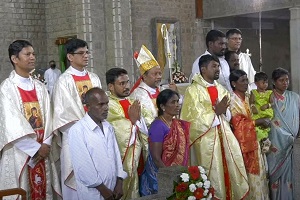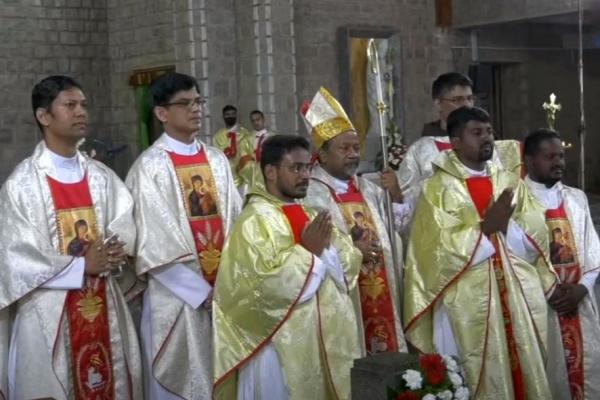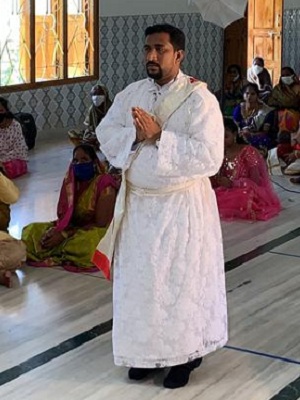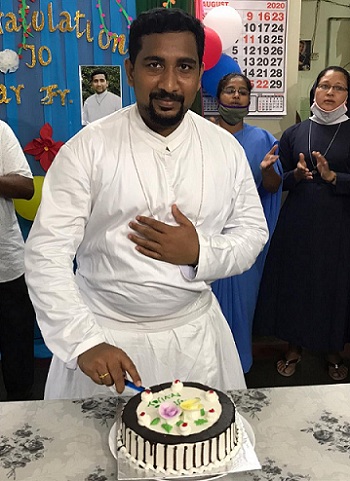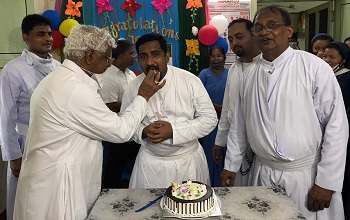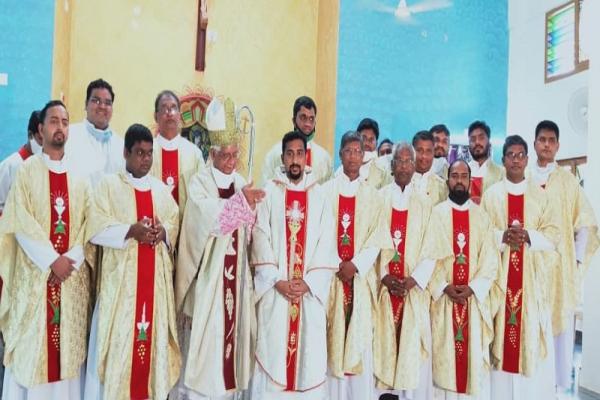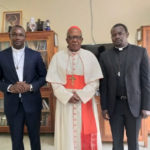Created some time after 1300, and brought to Italy in the following century, the icon of Our Mother of Perpetual Help found a place of veneration in the Church of St. Matthew, on Via Merulana, Rome in 1498. The icon is not an artistic masterpiece, but arguably it is one of the most popular images of Mary in the world – especially Asia and South America. Novena devotions—in churches and chapels, homes and hospitals, on TV and radio, and on the internet—nourish the faith and prayer of millions of devotees. The image is found in numerous houses and churches. This popularization has taken place since 1866 – the year when the Redemptorists were given the care of the icon and mandated by Pope Pius IX to make her known to the world.
It is said that the Child represented in the icon has the features of a 12-year-old boy – the age at which Jesus was taken to the Temple and began to engage in his Father’s business. He now becomes aware of His nature as the Son of God. He is looking upwards, not towards the Archangel Gabriel who is bearing the cross, but beyond this spiritual creature to God, His Father in Heaven. Mary is seen as presenting the Son of God to us. Jesus-Mary-ourselves are the three elements seen in relation to each other. “After this our exile, show unto us, the blessed fruit of your womb, Jesus.”
Jesus-Mary-Humans in Exile:
John Paul II said in Redemptoris Mater (1987) #11:
In the salvific design of the Most Holy Trinity, the mystery of the Incarnation constitutes the superabundant fulfillment of the promise made by God to man after original sin, after that first sin whose effects oppress the whole earthly history of man (cf. Gen. 3:15). And so, there comes into the world a Son, “the seed of the woman” who will crush the evil of sin in its very origins: “he will crush the head of the serpent.” As we see from the words of the Protogospel, the victory of the woman’s Son will not take place without a hard struggle, a struggle that is to extend through the whole of human history. The “enmity,” foretold at the beginning, is confirmed in the Apocalypse (the book of the final events of the Church and the world), in which there recurs the sign of the “woman,” this time “clothed with the sun” (Rev. 12:1).
Mary, Mother of the Incarnate Word, is placed at the very center of that enmity, that struggle which accompanies the history of humanity on earth and the history of salvation itself. In this central place, she who belongs to the “weak and poor of the Lord” bears in herself, like no other member of the human race, that “glory of grace” which the Father “has bestowed on us in his beloved Son,” and this grace determines the extraordinary greatness and beauty of her whole being. Mary thus remains before God, and also before the whole of humanity, as the unchangeable and inviolable sign of God’s election, spoken of in Paul’s letter: “in Christ…he chose us…before the foundation of the world, he destined us…to be his sons” (Eph. 1:4, 5). This election is more powerful than any experience of evil and sin, than all that “enmity” which marks the history of man. In this history, Mary remains a sign of sure hope.
Mary stands on the one hand in her relationship to Christ best described by Dante in the words :
O virgin mother, daughter of thy Son,
humble beyond all creatures and more exalted;
predestined turning point of God’s intention.
On the other hand, she stands in constant, steady relationship to people as Mother of Perpetual Help. It is an altogether unique and multi-faceted relationship.
Mary, Mother of Jesus, Mother of Mercy
Mary “blessed’ by God’s gift – Mary “happy” because of her option for God:
Luke says that Mary is “blessed” (eulogomene) – blessed among women, blessed in the fruit of her womb. But she is happy (makaria) because she believed what was spoken to her by the Lord. The first is gift and the second, Mary’s contribution to salvation history. That is the key in which the history of Jesus-Mary-People relationship stands and continues through history. The interplay of what God gifted to Mary and Mary’s option as a free human being, accepting and entering into God’s plan takes place in the context of God’s mercy. There are only six occurrences of the noun eleos (mercy) in Luke and he employs the term abundantly (5 out of 6) in his infancy narrative, particularly in the canticle of Mary “Magnificat” and in the canticle of Zechariah “Benedictus: “mercy on those who fear him from generation to generation”; “in remembrance of his mercy”; “the neighbours and kinsfolk heard that the Lord had shown great mercy to [Elizabeth]”; “to perform the mercy promised to our fathers”; “through the tender mercy of our God, when the day shall dawn upon us from on high, to give light to those who sit in darkness and in the shadow of death, to guide our feet into the way of peace”.
In every part of the world, no matter the religious affiliation, race, language and economic situation of people, what happened in the case of Mary continues – according to the catholic tradition, the interaction between God’s gift and human choice in the context of God’s mercy. In the context of Asia, the icon of the Mother of Perpetual Help is an embodiment and symbol of this continuing interplay in today’s world.
At each Eucharist, we pray that we may become partakers of his divinity, who deigned to share our humanity. And the falling sandal and the visibility of the sole of the foot has been interpreted in this light. In the Old Testament, (e.g. Ruth, Amos) passing a sandal to another person means to conclude a contract. The Child is allowing the sandal to fall down towards us, which means that He is establishing a contract with us: this contract is the new covenant. At the same time, He is showing the sole of His foot. In Oriental iconography, to show the sole of one’s foot means to show one’s own nature, which in this case is human nature. However, this gesture also has another meaning. To touch a patch of land one intended to buy with the sole of one’s foot was the sign indicating that one had become its owner. Jesus, in becoming man and touching the earth, has reclaimed ownership of the earth, of creation, and by restoring humanity to its dignity as sons of God, has restored to humanity its lordship over all creation.
“Mercy on those who fear him from generation to generation”:
God looked on the lowliness of Mary and he continues to look in mercy on those who fear him. The experience of God and of the “fear of the Lord” is expressed in a variety of ways in Asia. The sociological context is one of immense poverty. In India, many million live on less than $2 a day. But even in the midst of poverty, there is a deep religiosity expressed by the celebration of religious festivals, building of shrines and churches, contribution to charitable projects and the like. “Rich gods and poor people” is the paradox of most of Asia.
Though corruption and poverty are universal, they have different faces and causes in every country. Concerning India, its great leader, Mahatma Gandhi has opined: “The world has enough for everyone’s need, but not sufficient for everyone’s greed.” India is one of the richest countries in her natural resources. Yet a vast majority of its people lives below the poverty line due to centuries of exploitation by its rulers in the past, and corrupt politicians of the present, resulting in an unequal distribution of wealth. Poverty in a country like Cambodia is not merely of material things, but also one of trust deficiency. Human relationships are practically impossible without the basic trust. In a country like Singapore, which ranks third in the highest per capita income in the world, even though it exists in Asia, it is infested with the malady, as articulated by Mother Teresa of Calcutta: “The greatest disease in the West today is not T.B. or leprosy, it is … a different kind of poverty- it is not only a poverty of loneliness, but also of spirituality.” In their culture of capitalism and consumerism, people are expected to earn as much as possible to secure a better future. The exhausting work culture drains out one’s energies and time, rendering one a victim without proper rest or family life. There is a kind of self-imposed enslavement for gaining material prosperity. The Christians in some of the countries, like Pakistan and Malaysia, are under constant threat of persecution and discrimination. The situations in some other countries are quite similar. The people of God are either discriminated against or threatened on the basis of economic, ethnic, linguistic or political affiliations. They suffer due to the injustice and the indifference of others.
“The Almighty works marvels for me; holy is his name”
In their experience of oppression, deprivation or discrimination, these poor and victimized people turn to God for help and vindication. They have nowhere else to turn. Like the people of the Old Testament in exile, they seek divine intervention in some form or other. They believe that God and God alone can redeem them. There is no other – as we constantly hear in the psalms. But there is the memory of what God has done in and for Mary; and what Mary through her intercession and mediation does for us.
In approaching Mary, through such regular devotions as the Novena or annual festivals at Marian shrines, people – irrespective of their religion – find a context and situation in which they can cry like the psalmist bordering on despair, but with the hope of intervention. “But as for me, my feet were almost gone; my steps had well nigh slipped. For I was envious at the foolish, when I saw the prosperity of the wicked…. Until I went into the sanctuary of God; then understood I their end. Surely thou did set them in slippery places: you cast them down into destruction…”(Ps 73:1-19). The large number of people attending Novena devotions in our various churches and pilgrim centers, and the increasing number of people registering for R.C.I.A. (Rite of Christian Initiation of Adults) in places like the Novena Church in Singapore, are indications that they have not given up their hope and trust in God. Our churches are visited as places of encounter with God, even by people of other faiths.
Testimonies of the people, who have experienced divine intervention in their life, at the Novena devotions, retreats and renewal programs, the growing interest of people in pilgrimages and overseas mission trips are some of the signs that people express their need of God. Thus, they look for persons and means which can satiate this need. Correspondingly, there is also a large number of people who feel disillusioned with religion and spirituality, and look for alternate means of self-fulfillment, like drugs, and various other forms of addiction.
Devotion to the Mother of Perpetual Help functions something like activity in a “field hospital”. Pope Francis notes, “The thing the church needs most today is the ability to heal wounds and to warm the hearts of the faithful; it needs nearness, proximity. I see the church as a field hospital after battle. It is useless to ask a seriously injured person if he has high cholesterol and about the level of his blood sugars! You have to heal his wounds. Then we can talk about everything else. Heal the wounds, heal the wounds. … And you have to start from the ground up.”
Mary as Mother, the life-giver
Jesus is the universal savior. Mary is the mediator of grace. In this role,
1. Mary is the author of the Magnificat- the victory song of the anawim. From her own experiences she testifies that God is always on the side of poor and the marginalized. He is ‘Emmanuel’ – a God who is with us. Out of her own experiences, she could say with the psalmist, “This poor man called, and the Lord heard him; he saved him out of all his troubles.” (Ps 34:6). The suffering expressed in the psalms and the cries for help from God rise from the dire poverty of the Asian poor. For such as these, Mary remains a beacon of hope in their hopelessness and in their life of helplessness.
2. Mary is the symbol of a disfigured world. As Gandhi said, “The world has enough for everyone’s need, but not sufficient for everyone’s greed.” But in this world, Mary’s canticle proclaims: “He has put down the mighty from their thrones and sent the rich hungry away”. That is the promise of a world transfigured by God’s power. In the paschal Mystery, the power of powerlessness overpowers the powers of darkness. She witnessed that the crucified Jesus is the Risen Lord. Man cannot defeat God’s plans and purposes. Ultimately God will be victorious and all those who place their trust in God will see the salvation of God. The disfiguration and dehumanization of human beings continues even today, wherever, people are deprived of their rights and identity. To hope against hope, when everything seems to be lost, is possible only for a person who clings on to God, saying, “Father into your hands I commit my spirit” (Lk 23:46). “But they that wait upon the Lord shall renew their strength; they shall mount up with wings as eagles…” (Is 40:31).
3. Mary’s spirituality is a Comprehensive Spirituality. Being the cradle of the great world religions, spirituality is one of the greatest assets of the Asian people. There are different schools of spirituality that the people are familiar with.
In Indian spirituality, there is the Jnana-marga (path of knowledge/ wisdom), Karma-marga (path of action, ortho-praxis) and Bhakti-marga (path of devotion/ contemplation). In Mary’s life, one finds an integration of all these three: “Mary treasured up all these things, pondering them in her heart” (Lk 2:19). When she heard that her cousin, Elizabeth is expecting a child, “she went in haste to serve her”. In the Gospel of Luke, she was the virgin at prayer at the time of annunciation, and accompanied the disciples in prayer in the upper room after the resurrection till Pentecost.
In Buddhism, the three ultimate causes of suffering are 1.Greed and desire, represented in art by a rooster; 2. Ignorance or delusion, represented by a pig; 3. Hatred and destructive urges, represented by a snake. The path to liberation from suffering is the eightfold path. Mary in her immaculate conception represents the experience of liberation (nirvana) already in this life. Nirvana is understood as a state of mind that humans can reach. It is a state of profound spiritual joy, without negative emotions and fears. She lived that faith and joy in the events that are reported about her, even though at times she did not understand at the time what was happening (as when the shepherds reported what they had seen and heard; when the boy Jesus was found in the Temple after three days). Islam has a devotion to Mary under the name of ‘Mariam, the mother of Jesus.’
4. Mary is Mother and teacher. Modern psychology speaks about the three types of learning: the ‘visual’ – (seeing is believing), ‘auditory’ – hearing and understanding; and ‘kinesthetic’- learning from experiencing; Thomas had to touch and believe. Mary’s faith in God was total and unconditional at the time of annunciation; but eventually built up by what she has seen, heard and experienced in her life with Jesus. As we go through the accounts where Mary is mentioned in the Gospel, one cannot help noticing how rich her life is that all of us have something to learn from her, and yet how simple her examples are that we all can imitate her. Mary is the ideal Mater et Magister. Mary in the New Testament – does not figure in a role of a proclaimer of the word, rather it is a role of servant of the word and support for the proclamation. The last appearance of Mary is in the Acts of the Apostles where together with the College of Apostles she awaits the coming of the Spirit and receives the Spirit just as they did. But there is no record of her joining Peter in proclaiming the word. However, in Rev 12, the woman clothed in the sun is considered to be Mary in glory – what the Church through proclamation, celebration and living the world will be at the end of time.
5. Mary gave Jesus to the world. As Pope Francis said at the Christmas Mass (2015): “Today, the Son of God is born, and everything changes. The Saviour of the world comes to partake of our human nature; no longer are we alone and forsaken. The Virgin offers us her Son as the beginning of a new life. The true light has come to illumine our lives so often beset by the darkness of sin. Today we once more discover who we are! Tonight, we have been shown the way to reach the journey’s end. Now must we put away all fear and dread, for the light shows us the path to Bethlehem.” In Luke’s gospel, the most important revelation in the birth narrative of Jesus is given to the shepherds: “for to you is born this day in the city of David a Saviour, who is Christ the Lord”. Later on taking Jesus into his arms, Simeon will say “mine eyes have seen your salvation”. Jesus is God’s Saviour, God’s mercy, forgiveness and love. All this takes place in accordance with the covenant with the fathers and mentions Abraham: (i) “He has helped his servant Israel, in remembrance of his mercy, as he spoke to our fathers, to Abraham and to his posterity forever” (Lk 1,54-55); (ii) “to perform (poieō) the mercy promised to our fathers, and to remember his holy covenant” (Lk 1,72).
6. People of our times are desperately in need of an experience of God in their lives. Mary gave birth to her first-born son and laid him in a manger. Accidentally and providentially there was no place in the inn. The non-availability of the inn is mentioned in passing to justify the birth in the manger. Jesus is born in a stable, so that the lowest rung of the Palestinian society could come and feel at home. The shepherds who come to the manger are now at home with the Saviour, and the Saviour is at home with the shepherds.
Luke in his gospel will show that Jesus will be at home with the marginalized of the Palestinian society. So much so, he will be accused of such affiliations and will have to justify his options stating that those who are well do not need a physician, but those who are sick, and that he has not come to call the righteous but sinners (Lk 5,29-30). This child of Mary will go in search of all who are lost, saddened and out in the cold, and will take their side without forgetting the others. And that will cost him his life, because the mighty of the earth would not tolerate it. He will be understood and accepted by the Father who confirms the Son in His love. He becomes one with the Father, himself living a life of liberation for others.
Jesus in the manger reminds us that God is on a journey with the oppressed of the earth. If this manger is God’s norm, then we are assured that our merciful God is on a journey with the small farmers, small fishermen, victims of war, plantation workers and urban poor, to name a few of God’s preferred in this land. He becomes our God when we dare to be merciful like Him (Merciful like the Father) and journey with Him with the shepherds of the earth, the oppressed of the earth.
Mary in her own life prefigures this spirit of Christ and her care continues even now. Mary’s place in Salvation history makes her outstanding in sharing her God experience with others. On her visit to Elizabeth, the latter acclaimed her as the mother of God, as she felt the child in her womb already exalting in the presence of the unborn Savior! Mary enabled the couple at Cana to benefit from the first miracle of Jesus when the servants did what Jesus told them. Down through the history, the church experienced her mediation in receiving God experience through her Son. Even today, Mary bridges the gap between God and us, by bringing us closer to each other.
Mary: God’s gift to the World – Popular Devotion: the response of the lowly:
Popular devotion is an important part of the life of the church; in fact, the life of any religion. Take away popular devotion and you take away the ability of religion to warm hearts. Traditional popular piety has kept so many people flocking to shrines and even through current crisis and secularization of our times. They make the life of faith tangible and existential.
Popular piety has a three-fold function in the life and spirituality of the poor, especially in the Asian and Latin American countries.
First of all, popular piety offers consolation. Pope Francis has said: “I think of the steadfast faith of those mothers tending their sick children who, though perhaps barely familiar with the articles of creed, cling to a rosary; or of all the hope poured into a candle lighted in a humble home with prayer for help from Mary, or in the gaze of tender love directed to Christ Crucified.” The icon of Mother of Perpetual Help has a special attraction for the Asian people. In the icon, Mary seems to wear an Asian attire. Her eyes are fixed upon the eyes of the devotees, with a positive attraction drawing towards her. The way she holds the child Jesus in the crisis situation enables the poor and suffering are able to identify themselves with Jesus. The icon evokes a sentimental attraction and attachment, like a child towards its mother. And the thanksgiving letters pouring in every week in these shrines are a testimony that their devotion and prayers are bearing fruit and bringing fulfillment.
Secondly, popular devotion leads to conversion: The popular devotions, especially in Marian Shrines, do not end with the final blessings, but frequently the people approach the sacrament of Reconciliation. Often, in the context of popular devotion, it is a real conversion experience. It is an opportunity for the people to open up their hearts’ burdens, to discern God’s will in that particular moment of their life, to be affirmed of their identity as a beloved child of God, and be assured of the welcome and home-coming in the Father’s house, like the Prodigal Son. Even persons of other faiths approach the clergy for spiritual guidance and prayer support.
Thirdly, popular piety transforms: Personal conversions often lead to radical changes in one’s life and attitudes. This brings about visible transformation in their families and circumstances. Even one person can be an entry point for Christian faith and values into a family not professing the Christian faith. These persons truly function like the salt of the earth or the light of the world in their families and surroundings. In many cases, it eventually results in the conversion of the whole family. These conversions mean, a radical change in their mind-set from that of a materialistic or atheistic outlook. They begin to value and respect human persons, begin to love people and use things realizing the transitory nature of material things. The Christian and Gospel perspective can bring about a radical change in a person’s world and world-view.
Conclusion:
Asia is battered by the challenges of modernism and globalization along with that of secularization and materialism. Even though at one time in history, India for example, enjoyed one of the highest standards of living in the world, the sociological situation today is one of widespread poverty, which will take a long time to eradicate. At the same time, Asia and the Middle East is the locus from which the great religions of the world have emerged. In Asia especially, the culture is deeply rooted in religiosity. But the modern idols displayed in the media and the trends of consumerism often render it difficult, if not impossible, to uphold religion and spirituality as a top priority. In particular, there is also a growing intolerance against the Christian faith from today’s fundamentalists and secularists.
At the same time, there are people who feel the need of a God who can save them from the tensions, frictions and frustrations of the daily chores of life. The Church’s traditional answers are no longer relevant to the new challenges faced in the present day situations. The challenge to religion is no longer between faith and reason (as it was at the time of Vatican Council I), nor between faith and historical situations (as it was at the time of Vatican II, demanding ecumenism), but it is between faith and life experience. What people need is not merely orthodoxy or orthopraxis, but more a faith that can bring a difference in the quality of one’s life and provide direction and meaning to life.
Christians are of the view that Christianity has the fullness of God’s revelation in Jesus, the Son of God. But we need to retrieve the core of the Christian revelation of a God, who is love, and a morality that is to love, and to build a community of love that foreshadows the Kingdom of God. Mary had been an integral part of God’s salvation history. As we say in the preface for the feast of the Immaculate Conception: “You allowed no stain of Adam’s sin to touch the Virgin Mary. Full of grace, she was to be the worthy mother of your Son; your sign of favour to the Church at its beginning, and the promise of its perfection as the bride of Christ, radiant in beauty. Purest of virgins, she was to bring forth your Son, the innocent lamb who takes away our sins. You chose her from all women to be our advocate with you and our pattern of holiness.”
Jesus and Mary go together. Mary gave us Jesus; but Mary is blessed not because of the physical relationship to Jesus, but because she believed. “O virgin mother, daughter of thy Son, humble beyond all creatures and more exalted; predestined turning point of God’s intention.” (Dante). Her mission is always to lead all to Christ. And she who always responds to the cries of the poor and helps us in this vale of tears, accompanies us to our journey’s end. After all, she is for us – Our Mother of Perpetual Help.
Fr. George Puthenpura, CSsR
Province of Bangalore








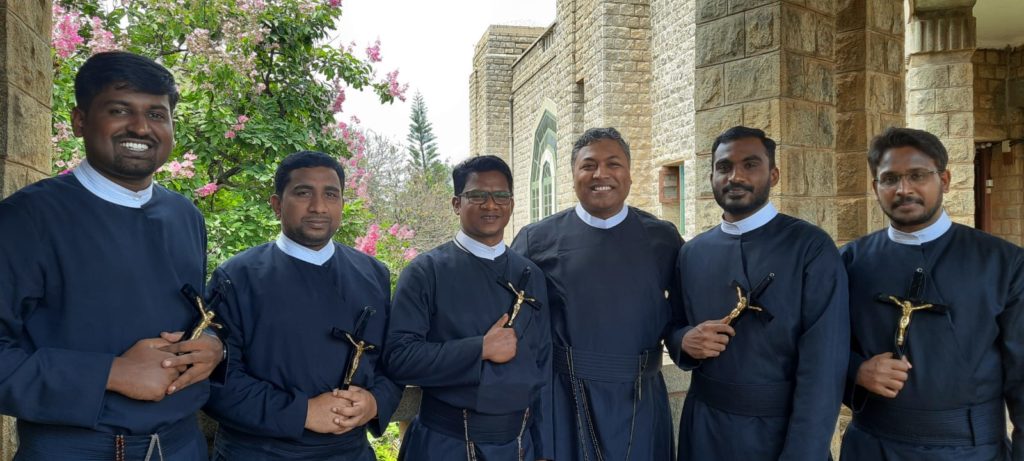
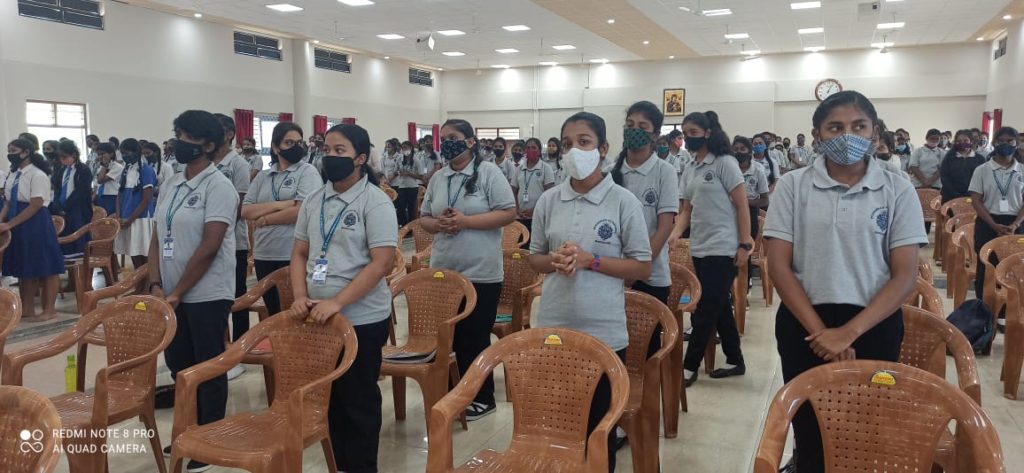

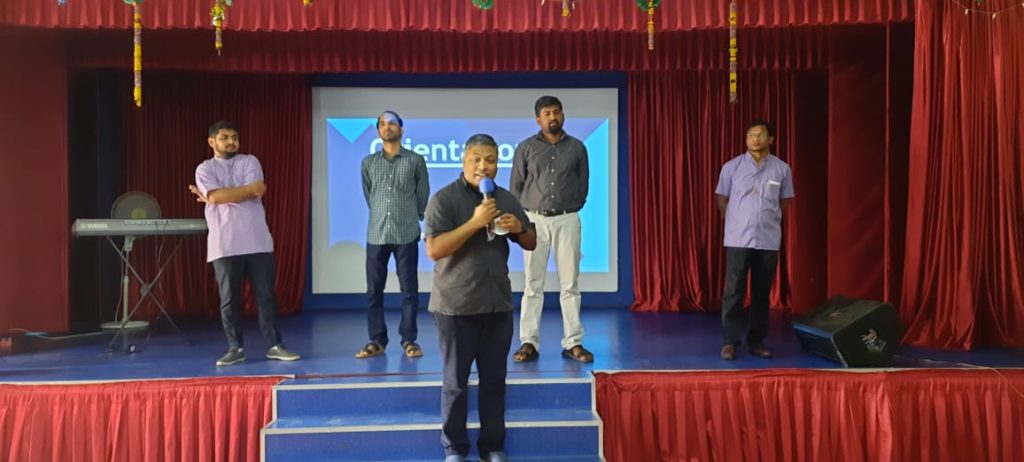


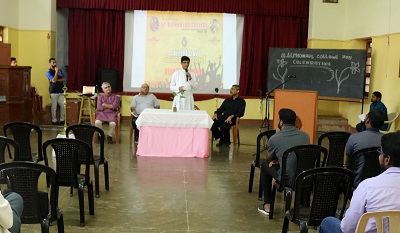 The year 2014 was significant in the history of St. Alphonsus College. Until then, it was the Theologate of the Redemptorist Province of Bangalore. In 2014 St. Alphonsus College became the Common Theologate of all three Redemptorist Units in India (Bangalore, Liguori, and Majella). This was in response to the Restructuring process begun in the Congregation. This called for more collaboration between Units of the Congregation in different areas. The Units in India responded to the call of the General Chapter for more collaboration in varied ways, especially in the area of formation of young Redemptorists. Accordingly, in2014, a Memorandum of Understanding was signed by the 3 Major Superiors making St. Alphonsus College the common Theologate of the Redemptorists in India.
The year 2014 was significant in the history of St. Alphonsus College. Until then, it was the Theologate of the Redemptorist Province of Bangalore. In 2014 St. Alphonsus College became the Common Theologate of all three Redemptorist Units in India (Bangalore, Liguori, and Majella). This was in response to the Restructuring process begun in the Congregation. This called for more collaboration between Units of the Congregation in different areas. The Units in India responded to the call of the General Chapter for more collaboration in varied ways, especially in the area of formation of young Redemptorists. Accordingly, in2014, a Memorandum of Understanding was signed by the 3 Major Superiors making St. Alphonsus College the common Theologate of the Redemptorists in India.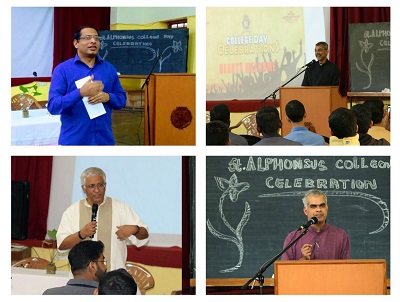

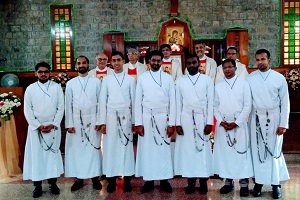


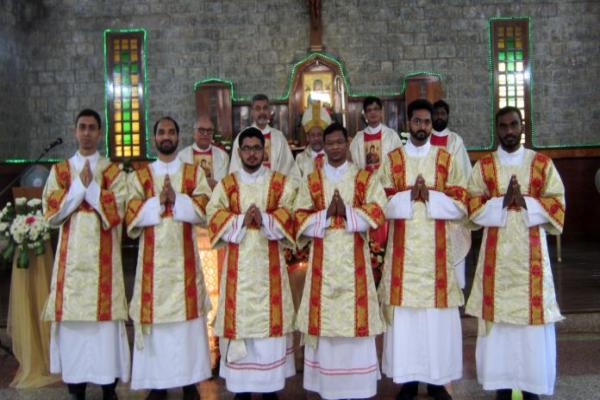

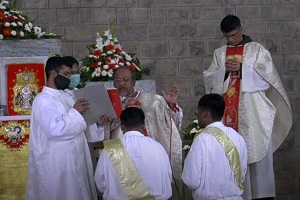 The ceremony began with a brief recounting of their journey from the time they entered the Redemptorist community. It was followed by the celebration of the Holy Mass. Apt to the occasion, the gospel reading chosen was that of St. John, where Jesus said to his disciples, “I chose you, and I commissioned you to go out and bear fruit, fruit that will last.” The reading of the gospel was followed by the Rite of Ordination. The candidates (deacons) were presented to the Archbishop who addressed them and the gathering, on the duties of priesthood.
The ceremony began with a brief recounting of their journey from the time they entered the Redemptorist community. It was followed by the celebration of the Holy Mass. Apt to the occasion, the gospel reading chosen was that of St. John, where Jesus said to his disciples, “I chose you, and I commissioned you to go out and bear fruit, fruit that will last.” The reading of the gospel was followed by the Rite of Ordination. The candidates (deacons) were presented to the Archbishop who addressed them and the gathering, on the duties of priesthood.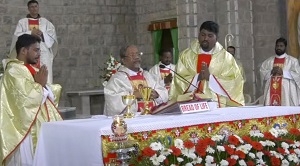 ones being ordained, with the prayer of consecration for them to be faithful to their ministry.
ones being ordained, with the prayer of consecration for them to be faithful to their ministry.
